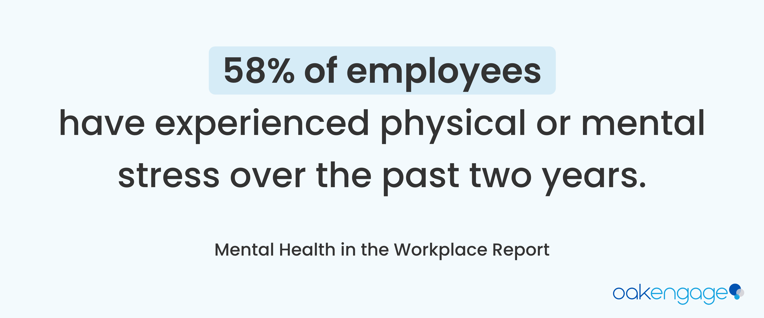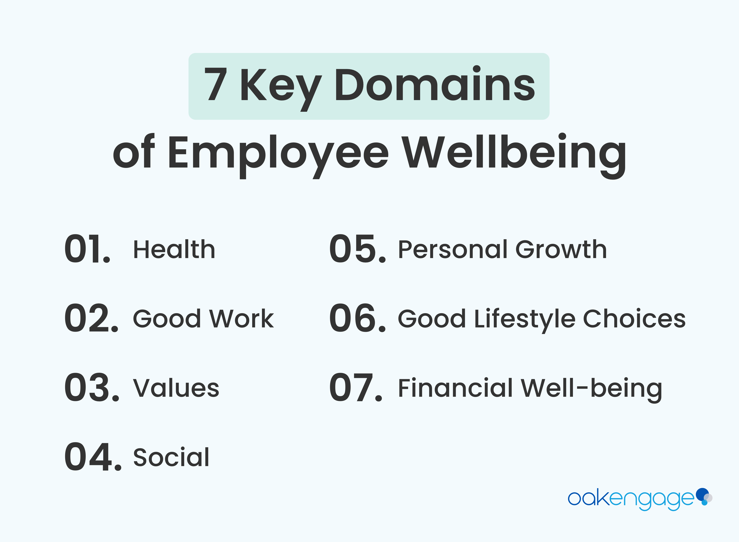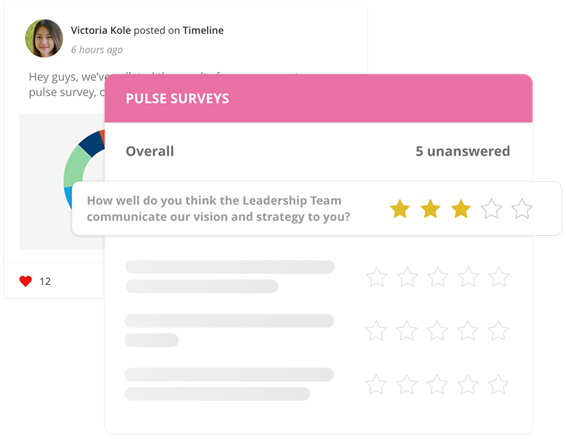Employee wellbeing should be at the forefront of what an organisation does. Workers are no longer willing to stay in jobs where they feel like their health and happiness is not a priority, and rightly so. Corporate wellbeing should be a cornerstone of any organisation.
However, Oak's Mental Health in the Workplace Report found that 58% of us have suffered mental or physical stress over the last 2 years because of work. Companies must do better to ensure that their employees feel valued, and that their wellbeing is at the top of their priority.

What is employee wellbeing?
Employee wellbeing being is essentially how an employee feels about various aspects of their life – their home life, their health, their relationships with others, their job and other factors. It’s about how their role impacts these things.
When talking about employee wellbeing, think about it as the way employees’ duties, expectations, stress levels and working environments affect their overall health and happiness.
What is employee wellbeing in the workplace?
Employee wellbeing relates to all aspects of working life, including the environment employees work in, the climate in the workplace and how a workforce feels about their day to day work. Well-being is a key factor determining an organisation's long-term success and effectiveness.
According to the CIPD’s health and wellbeing report, HR managers identified within a survey that only 40% of UK businesses have a standalone employee wellbeing strategy. What’s more, mental health is responsible for 56% of long-term unplanned absences, making it the most common cause of long-term absence.
What is the difference between employee wellbeing and employee engagement?
Employee wellbeing covers all types of wellness, such as:
- Physical health
- Emotional health
- Psychological Wellbeing
- Social relationships
- Financial stability
Essentially, employee wellbeing looks at employee experience at work from a holistic view and asks, “do they have what they need to do their best work?”. This is important for reducing work related stress or instituting incentives for healthy living.
Employee Engagement on the other hand, is the emotional commitment the employee has to the organisation and its goals. It has been proven to:
- Reduce staff turnover
- Improve productivity and efficiency
- Increase employee retention
- Deliver higher profits
- Boost business connectivity and performance
- Reduction in absenteeism
Why is employee wellbeing important?
Focusing on employee wellbeing not only creates happier workers, it has a significant impact on the bottom line. Corporate wellbeing should always have its roots in the interests of your employees but it's important to consider the cost saving implications it can have on retention and more.
The benefits of making wellbeing a top priority in the workplace are:
- Improved team focus
- Reduce of stress
- Increased job satisfaction
- Positivity among employees
- Improved general wellbeing
Remember that employees are the biggest asset you have, so ensure that wellbeing initiatives of focused around YOUR people and their needs.
Domains of employee wellbeing
CIPD have identified 7 key domains of employee wellbeing that you should consider and start implementing before putting together a strategy.

1. Health
Physical Health - Health checks, wellbeing benefits, health insurance protection, managing disability, occupational health support, employee assistance programmes.
Mental Health - Stress management, conflict resolution training, training line managers to have difficult conversations, risk assessments.
2. Good work
Working Environment - Ergonomically designed working areas, open and inclusive culture.
Good Management - Effective people management policies, training for line managers, sickness absence management.
Work Demands - Job roles, job quality, workload, working hours, job satisfaction, work-life balance.
3. Values/principles
Leadership - Values-based leadership, clear mission and objectives, building trust with employees.
Ethical Standards - Dignity at work, corporate social responsibility.
Diversity - Diversity and inclusion, valuing difference, cultural engagement.
4. Collective/social
Employee Voice - Communication, involvement in decision making.
Positive Relationships - Management style, teamwork, respect.
5. Personal growth
Career Development - Performance management, mentoring, succession planning.
Emotional - Positive relationships, personal resilience training, financial wellbeing.
Creativity - Open and collaborative culture, innovation workshops.
6. Good lifestyle choices
Physical Activities - Walking/running clubs, lunchtime yoga, charity walks.
Healthy Eating - Recipe Clubs etc
7. Financial wellbeing
Fair Pay and Benefits Policies - Pay rates above the statutory national minimum wage, flexible benefits scheme.
Retirement Planning - Pre-retirement courses for people approaching retirement.
Recommended Reading 📖: How to Beat Office Anxiety
How to improve employee wellbeing
We understand that it can be tricky to start building an employee wellbeing strategy, so we’ve put together 11 top tips on how you can start improving employee wellbeing within your organisation today.
Tip 1: Communicate effectively
Poor communication in the workplace will inevitably lead to unmotivated staff that may begin to question their own confidence in their abilities and organisation.
Utilise Pulse Surveys with analytics to measure sentiment in the workforce . Some people may want personalised support, but by asking the following types of questions you can understand what kind of employee wellbeing strategy you may wish to offer your employees.
Survey questions may include:
- Are you in a comfortable working environment?
- Is your workload manageable?
- Are you content with where you are in our career?
- Do you have a good work/life balance?
- Is there anything we can do to help you?

Keep your survey results anonymous. This way, your employees will feel like they have a safe place at work without worrying about social or professional repercussions.
Tip 2: Give recognition
Employee recognition in the workplace has to be a vital part of a company's culture. In today’s work environment, the companies with the most satisfied and engaged employees are the ones that have the best training programmes and well-skilled staff.
Oak’s employee recognition feature helps your company boost morale and let your employees know that you care by celebrating milestones like birthdays and work anniversaries. It has an inbuilt timeline, meaning your employees can comment on achievements at any time. This creates a positive working environment, which will in turn, boost morale and improve employee wellbeing.
Tip 3: Introduce flexible working
Consider offering flexible working so that your employees can fit their job around their needs. This could include flexible start and finish times or encouraging employees to take more frequent breaks.
By noticing the needs of your team, it will widely improve employee wellbeing across the company. Making sure your employees are happy and healthy should be one of your top priorities - if you care for your team, they will care for you and your company which will lead to higher employee retention.
Tip 4: Encourage personal development
Creating a culture of personal growth means ongoing training and development. Personal development is something that should be encouraged to strongly improve employee wellbeing. Personal development is not only about improving life at work, but personal life too.
Personal development starts from within, but it should be encouraged by employers, management and HR professionals to reinforce its positive effects. Those in HR may, in fact, be in the best position to set an example, inspire personal growth, and offer support to employees in achieving that growth.
Tip 5: Boost team relationships
In most cases, the key to a happy team comes down to whether they actually get along. To encourage good working relationships, you should implement more team building activities, informal meetings or lunches/evenings out to bring your team together.
Not only will this support a more fun and sociable atmosphere, it’ll also mean everyone is able to get their ideas and opinions heard. After all, there may be some members of the team that wouldn’t usually get the opportunity to properly interact beyond some brief small talk in the lift.
Giving employees a voice within your workplace will be key to boosting overall morale.
Tip 6: Encourage social interaction
Create social spaces where people can share their experiences with other like-minded members, therefore, increasing a sense of belonging.
Social tools used in the right way can unlock connections that used to be impossible and with every new connection comes with a new opportunity for social interaction.

Social tools used in the right way can unlock connections that used to be impossible and with every new connection comes with a new opportunity for social interaction.
Tip 7: Promote self-care
A Korn Ferry study reveals that 73% of American professionals were feeling burned-out and the top reasons cited were no separation between work and home and unmanageable workloads.
Most of us have no problem prioritising an extra work task for our manager or someone else even after having worked a long day, but the idea of prioritising ourselves and our health is not something many of us are accustomed to doing.
The flip side to this is that a lack of work-life balance can cause burnout and mental health issues. Oak Engage’s Mental Health in the Workplace Report found that 19% of employees who have suffered mental health did so as a result of burnout.
As a business, you can start by creating areas within your digital workplace to offer self-help and provide suggestions for simple ways in which employees can focus time on wellbeing.
Tip 8: Introduce work perks
Keeping employees happy while they’re working can be tricky. So introducing work perks and benefits is the perfect way to ensure that morale is always kept high in the workplace. This could be anything from team events to paying for your employees’ gym membership or exercise class.
Here at Oak, we’ve introduced Oak Bank Holidays to make sure employees get the rest they deserve. Just like an actual bank holiday, we shut down the office for the day and relax.
Having that extra time off really boosts productivity among teams, enabling employees to do the best work they can do and ultimately creating further success for your company.
Tip 9: Encourage good lifestyle choices
By making sure your employees are aware of the dangers of sitting long periods of time, and educating them on how they can keep moving throughout the day, you are helping prevent illness and maintaining a happy and healthy workforce.
Create communities and improve your culture. Hubs bring like minded people together through virtual groups where they can collaborate, strengthen bonds and grow together.
Tip 10: Give regular performance reviews
A performance review is extremely beneficial to employee wellbeing. By conducting a performance appraisal, they’ll have an idea of how they’re getting on in their role, identify areas for improvement and conduct a self-evaluation. It’s also a chance for your employees to give you feedback; this could be feedback about the performance review or feedback about leadership in your organisation. They’re a two-way process that requires a lot of communication from both parties.
It’s also important to conduct regular performance appraisals for the peace of mind of your employees. Being left in the dark about anything is unsettling, but when you’re left unaware of how well you’re performing it can feel worrying.
Tip 11: Implement a company intranet
If you haven't already implemented a corporate intranet, this is your opportunity to find a software to suit your needs. Not only can your intranet be a central location for HR and wellbeing policies, they can also create connections even when physical interactions may not occur.
Wellbeing and remote or hybrid working
Working from home can have a serious impact on wellbeing. It can affect it in two ways:
- Loneliness and Isolation
When separated from colleagues or a normal office/working environment, individuals can start to feel isolated and lonely.
Feelings of isolation can increase stress levels and bring a sense of disengagement to both an employee’s work and the company itself, both of which negatively affect emotional wellbeing.
- Burnout
When working remotely, it can be easy for work to seep into an employee’s personal time. Remote employees can often work longer hours and feel that they have to contribute more because they aren’t in the office. This lack of work-life balance can lead to high stress levels, which ultimately turns to burnout if left unresolved.
You can support the wellbeing of your remote employees by:
- Establishing boundaries between work and personal time
- Set up regular one-to-one meetings
- Encourage regular breaks
- Set wellbeing goals
- Check-in with your workforce
Now that you can put these 11 simple steps into practice, your company wellbeing strategy should start to be part of your workplace culture. It’s always important to identify the problems first before implementing a solution.
Oak Engage - supporting employee wellbeing worldwide
Oak Engage plays a pivotal role in promoting employee wellbeing within organisations. As a comprehensive employee engagement platform, Oak Engage is designed to foster a positive and supportive work environment, which directly impacts the overall wellbeing of employees.
One of the key ways Oak Engage contributes to employee wellbeing is by promoting a culture of recognition and appreciation. The platform allows team members to give and receive recognition for their hard work and contributions, fostering a sense of value and accomplishment. When employees feel appreciated, it boosts their morale and motivation, leading to increased job satisfaction and overall wellbeing.
Oak Engage facilitates open communication and feedback between employees and management. By encouraging employees to share their thoughts, concerns, and ideas through surveys or feedback channels, the platform empowers them to have a voice in shaping their work environment. This sense of agency and involvement in decision-making positively impacts employees' mental and emotional wellbeing, as they feel heard and supported by the organisation.
Furthermore, Oak Engage offers various tools and resources to support employee wellbeing initiatives. From wellness programs to mental health resources, the platform provides a centralised hub where employees can access information and support related to their physical and emotional health. This focus on employee wellbeing not only enhances their quality of life but also contributes to reduced stress and burnout levels, leading to a more engaged and resilient workforce.
In conclusion, Oak Engage plays a vital role in nurturing employee wellbeing through its focus on recognition, open communication, support resources, and social connections. By prioritising employee wellbeing, organisations using Oak Engage can create a thriving and healthy workforce, resulting in higher levels of engagement, productivity, and overall satisfaction.
To find out more about how Oak Engage can support employee wellbeing for your business, get in touch today.



